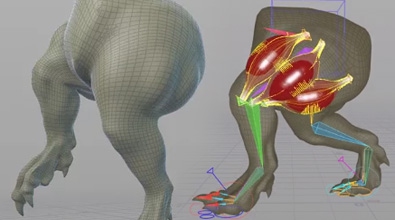john mariella
johm
About Me
Connect
LOCATION
Not Specified
WEBSITE
Houdini Skills
Availability
Not Specified
Recent Forum Posts
Muscle solver vellum issue April 20, 2024, 2:22 p.m.
If you want something really rigid... while it's not directly supported in the muscle solver, you could easily crack the HDA open and add a Vellum ShapeMatch constraint yourself.
Muscle solver vellum issue April 19, 2024, 9:20 a.m.
Thanks for the example SEGAS. The key difference is in your regular Vellum setup, you are using the stiffness parameters without a Scale by modifier. In the MuscleSolver, we use attributes to scale constraint stiffness values.
The Scale By factoring is not a linear scale.
If you look at a geometry spreadsheet for the Constraint Primitives, and watch what happens to the stiffness attribute for tetrahedral stretch, (Scale By Value behaves just like Scale By Attribute):
Stiffness: 1 x 1000
No Scaling yields a stiffness of 1000.0
Scale By Value: 1.0 yields stiffness = 1000.0
Scale By Value: 1.5 yields stiffness = 31669.0
Scale By Value: 2.0 yields stiffness = 1e6
Scale By Value: 10.0 yields stiffness = 1e30
Scale By Value: 100.0 yields stiffness = 1e37
So getting back to your original question, try using much lower stiffness values to see a difference. Once you start getting into higher Muscle Properties Stiffness values, the constraint stiffness starts to max out.
The Scale By factoring is not a linear scale.
If you look at a geometry spreadsheet for the Constraint Primitives, and watch what happens to the stiffness attribute for tetrahedral stretch, (Scale By Value behaves just like Scale By Attribute):
Stiffness: 1 x 1000
No Scaling yields a stiffness of 1000.0
Scale By Value: 1.0 yields stiffness = 1000.0
Scale By Value: 1.5 yields stiffness = 31669.0
Scale By Value: 2.0 yields stiffness = 1e6
Scale By Value: 10.0 yields stiffness = 1e30
Scale By Value: 100.0 yields stiffness = 1e37
So getting back to your original question, try using much lower stiffness values to see a difference. Once you start getting into higher Muscle Properties Stiffness values, the constraint stiffness starts to max out.
Muscle solver vellum issue April 18, 2024, 10:51 a.m.
That example file uses some significant Fiber Strength, and the muscles have a boosted lower end to the Fiber Scale range. (meaning that at their minimum muscletension, they still have fiber stiffness applied.) Fiber stiffness can make the muscles stiffer. Once you reach a high stiffness value, there may not be much visible difference. So maybe that's what you're seeing?
